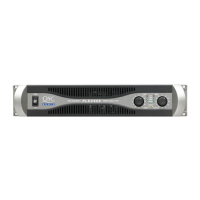Step Chattering.
If the step repeatedly switches on and off, usually at a low frequency, it creates an oscillation burst
which increases step glitch at low frequency. The tendency is usually worse at low impedances
and low frequencies. 2-3 “false trials” at very low frequency, 2 ohms, is normal, but prolonged
bursts of maximum frequency chattering may cause FET failure.
Positive step: check hysteresis resistor R66 (RI 89)
Negative step: check hysteresis resistor R69 (RI 92) and capacitor Cl 87 (Cl 93).
Slow or Fast Switching.
Slow switching reduces step glitch but puts more strain on the FET. Fast switching increases step
glitch. The usable limit is
17-27
volts/us,
If both slopes are equally off speed, check the slope capacitors:
Positive,
C30
(C65)
and Negative, C29 (C64).
If only one slope is slow, check the resistors and buffer transistors:
Positive step:
R78,
79,
Dl5,
Q30-31
(R201,
202,
D40,
Q7576)
Negative step:
R83,
84,
Dl7,
Q32-33
(R206,
207,
D42,
Q77-78).
Step FET Oscillation.
Certain FET types oscillate at extremely high frequency while ramping up and down. This injects
interference into the amplifier which increases the step glitch. Such problems are supposed to be
found while
(dis)qualifying
specific FET types. If they crop up in production, Engineering needs to
know.
STEP WON’T TURN ON (Premature Clipping)
If the step refuses to switch high, the amp will clip prematurely, at the intermediate rail, at any load. Make
sure the clipping is not
acually
current cutback, usually evident only at 2 ohms. Probe the output voltage
and intermediate rail voltages to confirm clip point and lack of step action. Trace the circuit from the step
FET back via gate drive to drive circuit to locate cracks, missing part etc. Check DC power on step driver
(14V
on EACH positive step drivers,
12V
on BOTH negative drivers). Check voltage of
PosRef
(20V below
+65V
rail) or Negref
(17.5V
above
-65V
rail). Look for severe mismatches of the comparator resistor
ladders.
STEP STUCK ON (Switched Rail Voltage Stuck On Full)
If the positive step is stuck on, (evidenced by permanent high voltage on switched rail) the FET is probably
bad, since the positive gate drive cannot sustain DC turn-on due to the bootstrapping. If the negative step
is stuck on, it could be a bad
FET,
or the gate drive circuit could be holding the FET on, which will easily be
confirmed by measuring the gate voltage. Malfunctioning gate drive circuitry should be checked as noted
above under “Won’t Turn On”.
REPEATED FET FAILURE.
Repeated failure of step
FET’s
is usually caused by failure to fully switch ON or OFF (lingering in the linear
region). The actual failure usually occurs at 2 ohms, where the dissipation is highest. After replacing the
FET,
the step waveform should be monitored, starting at light load to avoid repeated failure, and advancing
briefly to heavier loads while closely watching the waveform. You will need to use an isolated scope probe
which allows voltage readings to be taken with respect to the intermediate rails, or to FET sources.
FET Does Not Fully Turn On:
Generally causes problems at low frequency, 2 ohms.
Confirm that the step FET remains fully on for the entire cycle
(2OHz).
If not, confirm weak gate
drive and determine cause.
Weak positive drive: check voltage on C32
(C51)
for
14V.
Check
C31
(C66),
low RIO4
(R227),
missing D18
(Dl48).
Check
R78,
Dl5,
Q30
(R201,
D40,
Q75).
Weak negative drive: check voltage on
C67,
12V.
Check
R83,
Dl7,
Q32
(R206,
D42,
Q77).
20

